Albert Einstein
"I
want to know how God created this world. I
am not interested in this or that phenomenon, in
the spectrum of this or that element. I
want to know His thoughts; the rest are
details." -- Albert Einstein
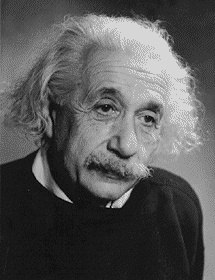 Einstein
Archives Online Einstein
Archives Online
The Einstein Archives Online Website provides the first online
access to Albert Einstein’s scientific and non-scientific
manuscripts held by the Albert
Einstein Archives at the Hebrew
University of Jerusalem and to an extensive Archival
Database, constituting the material record of one of the most
influential intellects in the modern era.
The site allows viewing and browsing of approx. 3,000
high-quality digitized
images of Einstein’s writings.
The site enables access to the online version of the Albert
Einstein Archives Finding
Aid, a comprehensive description of the entire repository of
Albert Einstein’s personal papers held at the Hebrew
University.
The Archival
Database allows direct access to approx. 43,000
records of Einstein and Einstein related documents.
http://www.alberteinstein.info
Albert
Einstein Online
S. Morgan Friedman
Eine sehr umfangreiche, gut gegliederte Linksammlung zu Leben
und Werk von Albert Einstein. Vorwiegend in englischer Sprache.
http://www.westegg.com/einstein/
Einstein
Einstein earned a doctorate from the University of
Zurich in 1905 for a thesis On a new determination of molecular
dimensions.
In the first of three papers, all written in 1905, Einstein examined
the phenomenon discovered by Max Planck, according to which electromagnetic
energy seemed to be emitted from radiating objects in discrete quantities.
The energy of these quanta was directly proportional to the frequency
of the radiation.
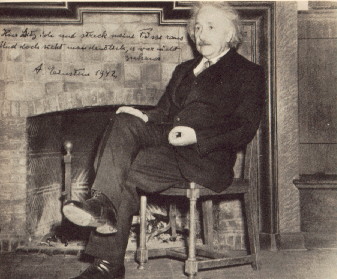 Einstein's second 1905 paper
proposed what is today called the special theory of relativity.
He based his new theory on a reinterpretation of the classical principle
of relativity, namely that the laws of physics had to have the same
form in any frame of reference. As a second fundamental hypothesis,
Einstein assumed that the speed of light remained constant in all
frames of reference, as required by
Maxwell's theory. Later in 1905
Einstein showed how mass and energy were equivalent. Einstein's second 1905 paper
proposed what is today called the special theory of relativity.
He based his new theory on a reinterpretation of the classical principle
of relativity, namely that the laws of physics had to have the same
form in any frame of reference. As a second fundamental hypothesis,
Einstein assumed that the speed of light remained constant in all
frames of reference, as required by
Maxwell's theory. Later in 1905
Einstein showed how mass and energy were equivalent.
The third of Einstein's papers of 1905 concerned statistical mechanics,
a field of that had been studied by Ludwig Boltzmann and Josiah Gibbs.
After 1905 Einstein continued working in the areas
described above. He made important contributions to quantum theory,
but he sought to extend the special theory of relativity to phenomena
involving acceleration. The key appeared in 1907 with the principle
of equivalence, in which gravitational acceleration was held to
be indistinguishable from acceleration caused by mechanical forces.
Gravitational mass was therefore identical with inertial mass. About
1912, Einstein began a new phase of his gravitational research,
with the help of his mathematician friend Marcel Grossmann, by expressing his work
in terms of the tensor calculus of Tullio Levi-Civita and Gregorio
Ricci-Curbastro. Einstein called his new
work the general theory of relativity. When British eclipse expeditions
in 1919 confirmed his predictions, Einstein was idolised by the
popular press. Einstein received the Nobel Prize in 1921 but not
for relativity rather for his 1905 work on the photoelectric effect.
http://www-groups.dcs.st-and.ac.uk/history/Mathematicians/Einstein.html
Einstein-Image and Impact. AIP History
Center exhibit.
"One thing I have
learned in a long life: that all our science,
measured against reality, is primitive and
childlike -- and yet it is the most precious
thing we have."
From before 1920 until his death,
Einstein struggled to find laws of physics far
more general 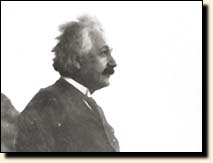 than any
known before. In his theory of relativity, the
force of gravity had become an expression of the
geometry of space and time. The other forces in
nature, above all the force of electromagnetism,
had not been described in such terms. But it
seemed likely to Einstein that electromagnetism
and gravity could both be explained as aspects of
some broader mathematical structure. The quest
for such an explanation -- for a "unified
field" theory that would unite
electromagnetism and gravity, space and time, all
together -- occupied more of Einstein's years
than any other activity. than any
known before. In his theory of relativity, the
force of gravity had become an expression of the
geometry of space and time. The other forces in
nature, above all the force of electromagnetism,
had not been described in such terms. But it
seemed likely to Einstein that electromagnetism
and gravity could both be explained as aspects of
some broader mathematical structure. The quest
for such an explanation -- for a "unified
field" theory that would unite
electromagnetism and gravity, space and time, all
together -- occupied more of Einstein's years
than any other activity.
http://www.aip.org/history/einstein/
Albert Einstein Home Page
Jesse Ralston - gralsto@humboldt1.com
"I want to know how God created this world.
I am not interested in this or that phenomenon, in the spectrum
of this or that element. I want to know His thoughts; the
rest are details." -- Albert Einstein
http://www.humboldt1.com/~gralsto/einstein/einstein.html
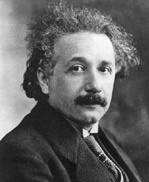 Albert Einstein Albert Einstein
Born: 14 March 1879 in Ulm, Baden-Wurttemberg,
Germany
Died: 18 April 1955 in Princeton, New Jersey, USA
Albert Einstein, “The Naked King of Physics,”
contributed more than any other scientist to the modern vision of
physical reality. His theory of relativity is held as human thought
of the highest quality. Einstein was a man ahead of his time with
ideas no one had ever dealt with before. Through his work he earned
fame and fortune, but he also earned hate and mistrust. Albert's
formula "E=mc2" was linked to the construction of the
Atomic Bomb, something Albert had never intended his work to be
used for.
Albert Einstein is undoubtedly one of the most fascinating
and influential figures of the modern era. Einstein won the Nobel
Prize and worked for the world peace. As a preeminent physicist,
he radically transformed our understanding of the universe. As an
ardent humanist, he took an active and outspoken stance on the significant
political and social issues of his time.
http://www.theworldofscience.com/einstein.html
Einstein by James Gleick
James Gleick
In this busy century, dominated like
no other by science—and exalting, among the
human virtues, braininess, IQ, the ideal of pure
intelligence—he stands alone as our emblem
of intellectual power. We talk as though humanity
could be divided into two groups: Albert Einstein
and everybody else.
 He
discovered, just by thinking about it, the
essential structure of the cosmos. The scientific
touchstones of our age—the bomb, space
travel, electronics—all bear his
fingerprints. He
discovered, just by thinking about it, the
essential structure of the cosmos. The scientific
touchstones of our age—the bomb, space
travel, electronics—all bear his
fingerprints.
Humanity was standing on a brink,
ready to see something new. It was Einstein who
saw it. Space and time were not apples and
oranges, but mates—joined, homologous,
inseparable. "Henceforth space by itself,
and time by itself, are doomed to fade away into
mere shadows," said Herman Minkowski, a
teacher of Einstein's and one of relativity's
first champions, "and only a kind of union
of the two will preserve an independent
reality." Well, we all know that now.
"Spacetime," we knowingly call it.
Likewise energy and matter: two faces of one
creature. E = mc2, as Einstein memorably
announced.
http://www.around.com/einstein.html
Welcome to A.E Homepage
Yashar Maleki
einstein's biography - eintein's
photo gallery - some of einstein's quotes -
einstein's theories and works - other einsteinian
pages links
http://www.geocities.com/CapeCanaveral/Hangar/6469/ein.htm
Albert Einstein's Scientific Works
http://www.humboldt1.com/~gralsto/einstein/scien.html
Die
Allgemeine Relativitätstheorie
Martin Kornelius - martin@kornelius.de
leicht verständlich erzählt als Bildergeschichte
· · eine kleine Einführung in die Ideen Albert
Einsteins · · ·
Noch kürzer,
noch einfacher: der schnelle Einstieg in die
Allgemeine Relativitätstheorie. Einfache Fragen, einfache
Antworten: Ganz
einfach...
http://www.kornelius.de/arth/index.html
Einstein, Albert, the Theory of
Relativity
Einstein, Albert (1879-1955),
German-born American physicist and Nobel
laureate, best known as the creator of the
special and general theories of relativity and
for his bold hypothesis concerning the particle
nature of light. He is perhaps the most
well-known scientist of the 20th century.
Teils in englischer, teils in italienischer Sprache.
http://www.italysoft.com/curios/einstein.htm
Special
Relativity theory made intuitive
Sylvain Poirier
Here is presented a new approach to explain the deep mathematical
meaning of Special Relativity theory, written like a philosophical
analysis with few but powerful formulas, and based on a transfer
of the Euclidean geometric tools and intuition to the pseudo-Euclidean
case. This aims to help get more directly close to the way this
theory is used in theoretical physics.
It is particularly addressed to those who, instead
of seeking to just handle relativistic properties by getting used
to them in a computational way and then wait until they get really
familiar, to finally grasp its meaning and go further, want to make
the effort necessary to really understand them more quickly and
deeply like theorician physicists do, according with the mathematical
terms in which this theory really appears as soon as one goes a
little further in mathematical physics.
Document
to download: how
to understand Special Relativity theory by geometrical intuition,
in .pdf
http://spoirier.lautre.net/en/relativity.htm
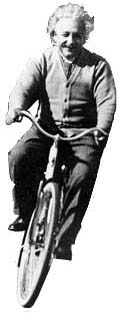 Everything's relative Everything's relative
http://whyfiles.news.wisc.edu/052einstein/
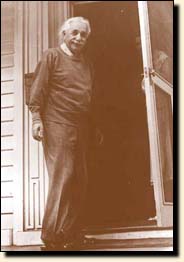 The World As I See It The World As I See It
Albert Einstein
"The most beautiful experience we can have is
the mysterious. It is the fundamental emotion that stands at the
cradle of true art and true science. Whoever does not know it and
can no longer wonder, no longer marvel, is as good as dead, and
his eyes are dimmed. It was the experience of mystery -- even if
mixed with fear -- that engendered religion. A knowledge of the
existence of something we cannot penetrate, our perceptions of the
profoundest reason and the most radiant beauty, which only in their
most primitive forms are accessible to our minds: it is this knowledge
and this emotion that constitute true religiosity. In this sense,
and only this sense, I am a deeply religious man... I am satisfied
with the mystery of life's eternity and with a knowledge, a sense,
of the marvelous structure of existence -- as well as the humble
attempt to understand even a tiny portion of the Reason that manifests
itself in nature."

http://www.aip.org/history/einstein/essay.htm
EINSTEIN'S LEGACY
Although he is regarded as one of
the most brilliant mathematical physicists of the
century, Einstein thought of himself as much as a
philosopher as a scientist. Certainly his
theories relating matter, energy, space, time and
gravity have guided much of the work in
theoretical physics since 1905. His famous
"thought experiments," based on
intuition and imagination rather than laboratory
work, propelled us beyond the mechanistic,
unchanging "clockwork universe" of
Newton and the other classical physicists into a relativistic
universe. Here clocks run slower or faster
depending on the speed of travel or location in
the universe, and "true" distances are
stretched or shrunk by gravity.
http://www.ncsa.uiuc.edu/Cyberia/NumRel/EinsteinLegacy.html
SCIENCE HERO - Albert Einstein
"Peace cannot be
achieved through violence, it can only be
attained through understanding." Albert
Einstein
Albert Einstein is a true science hero, not only
because of his genius and physics theories, but
also because of his philosophy and compassion for
the universe and its creatures.
http://myhero.com/science/einstein.asp
Einstein's letter to Roosevelt, August
2, 1939
Gene Dannen - gene@dannen.com
In the summer of 1939, six months
after the discovery of uranium fission, American
newspapers and magazines openly discussed the
prospect of atomic energy. However, most American
physicists doubted that atomic energy or atomic
bombs were realistic possibilities. No official
U.S. atomic energy project existed.
Leo Szilard was profoundly disturbed by the lack
of American action. If atomic bombs were
possible, as he believed they were, Nazi Germany
might gain an unbeatable lead in developing them.
Unable to find official support, and unable to
convince Enrico Fermi of the need to continue
experiments, Szilard turned to his old friend
Albert Einstein...
Einstein was willing to write to the President.
As a life-long pacifist, he opposed the making of
weapons, but he could not allow the Nazis sole
possession of such destructive power.
http://www.dannen.com/ae-fdr.html
MotivationalQuotes.Com presents Albert
Einstein
resources@motivationalquotes.com
Albert Einstein
(3/14/1879-4/18/1955) was a Nobel Laureate in
physics. Many people don't realize that as a
young man, Einstein was an indifferent student.
At the age of 12, he decided to solve the riddle
of the world, but he dropped out of school at age
15. He resumed school later in life, finishing
four years at the Polytecnic Academy in Zurich
studying physics. After graduation, he taught
math and worked as a patent examiner in
Switzerland. In 1905, he published his doctoral
thesis and was awarded his doctorate by the
Polytecnic Academy. In that same year he
published four other research papers that
outlined his theories on relativity, equivalence
of mass and energy (e=mc2), Brownian
motion, and the photon theory of light. The
theory of relativity was very controversial, and
although it was proven in 1919, the Nobel
committee did not mention it when bestowing the
prize.
http://www.motivationalquotes.com/People/einstein.shtml
Max Planck Institute for Gravitational
Physics (Albert Einstein Institute)
The Max Planck Institute for
Gravitational Physics (Albert Einstein
Institute) is one of more than 80 research
institutes of the Max Planck Society. The
Institute was established to pursue research in
gravitational physics, especially general
relativity and quantum gravity. General
relativity is the theory of gravity devised by
Albert Einstein; its many successful predictions
concerning black holes, gravitational waves,
gravitational lensing, and the Big Bang have made
it a standard tool of astronomers in their
attempts to describe the observed universe. Much
work in theoretical physics today is directed at
generalizing this theory to include the quantum
effects that are known to be necessary to
describe elementary particles, and which are
believed to be necessary as well to describe the
inside of a black hole and the details of the Big
Bang. The aim is to develop a quantum theory of
gravity that goes beyond general relativity and
explains the relationship between gravity and the
other forces of physics, such as electromagnetism
and the nuclear force.
http://www.aei-potsdam.mpg.de/
Einstein
Papers Project
The Einstein Papers Project (EPP) publishes in large book format
The Collected Papers
of Albert Einstein, an edition of twenty-five planned
volumes of Albert Einstein's scientific, professional and
personal papers, manuscripts and correspondence. Eight volumes
have been published so far by Princeton
University Press; two more are in preparation, to be
published within the next three years. Most of the original
documents in the Einstein collection are located at The
Albert Einstein Archives at the Jewish National and
University Library at the Hebrew University in Jerusalem.
http://www.einstein.caltech.edu/
Albert Einstein Archives
Albert Einstein (1879-1955)
bequeathed his literary estate and personal
papers to the Hebrew University of Jerusalem. These
papers constitute the Albert Einstein Archives,
housed at the Jewish National &
University Library since 1982. The Albert
Einstein Archives includes the largest collection
of original Einstein manuscripts in the world as
well as his vast correspondence with the most
influential physicists and intellectuals of the
twentieth century. In addition to being the proud
custodian of his papers, the Hebrew University
owns the copyright to all of Einstein's writings.
http://sites.huji.ac.il/jnul/einstein/
http://www.albert-einstein.org/
 SPUR
eines JAHRHUNDERTIRRTUMS SPUR
eines JAHRHUNDERTIRRTUMS
Günther Baer - spurfreunde@miriup.de
Albert Einstein gilt als der Vater unseres modernen
physikalischen Weltbildes. Jedes Kind kennt heutzutage seinen
Namen, mit seinen Theorien regte er die Phantasie der Menschen
an, wie kaum ein anderer Physiker unseres Jahrhunderts.
Zeitreisen, schwarze Löscher, Gravitationslinsen - jeder
physikalisch Interessierte kennt sie, die
"relativistischen" Phänomene. Und nun liest man
in der Presse: Einsteins Relativitätstheorie ist falsch.
Auch das hier veröffentlichte
Buch widmet sich diesem Thema und ist Ergebnis von
Untersuchungen, die der Autor vor über 20 Jahren begonnen hat.
Seine Hypothese stellt die Relativitätstheorie in Frage und
entwickelt das Weltbild weiter, das vor 1905 allgemein anerkannt
war.
Die wohl
bedeutsamste Kernfrage des Buches ist, wie lange wir es uns noch
leisten wollen und können, das Vakuum als stofflich leeren Raum
aufzufassen. Ein berühmtes Experiment, das als
Fundamentalversuch der Relativitätstheorie gilt und dessen
Wiederholung unter neuen Bedingungen in (5.6) vorgeschlagen ist,
wird darüber letztendlich entscheiden. Viele Wissenschaftler
beugen sich zweifelnd aber gefügig den zauberhaften
Auffassungen der modernen Physik, und viele Autoren wetteifern
phantasievoll und überschwenglich um die medienwirksamste
Darstellung von "Kaisers neuen Kleidern".
http://www.miriup.de/spur/
Relativitaetstheorie
und Mystik
Robert Markweger - rmw@aon.at
Wenn man sich voellig unvoreingenommen mit
Relativitaetstheorie beschaeftigt so kann man schon den
Eindruck gewinnen es in manchen Bereichen der RT mit glatter
Mystik zu tun zu haben.
Im Prinzip
beruht die SRT darauf dass man die Fortbewegung des Lichts
also insbesondere das Ergebnis des Michelsonversuchs unbedingt
mit einer Welle im Aether beschreiben wollte. Insofern ist die
SRT eine Folge der Wellentheorie des Lichts.
Tatsache ist
dass insbesondere der Michelsonversuch mit einem
Teilchenverhalten ohne weiteres erklaerbar ist, was im
Allgemeinen freilich grosszuegig uebergangen wird.
Nun, ich meine
dass das Licht in aller Konsequenz aus einzelnen
oszillierenden Teilchen besteht, ich sehe nicht welche
Eigenschaften des Lichts damit nicht beschreibbar sein
sollten.
Die Vorstellung
von schwarzen Loechern oder von einem Urknall haben ihre
Ursache in nichts anderem als dem beliebigen Fortschreiben
mathematischer Funktionen, diese Vorstellungen sind nur noch
schlichtester Mystik vergleichbar.
http://www.markweger.at/
Für
die Menschenrechte der Relativitätskritiker
Jonathan Tennenbaum
Von Anfang an war Einsteins spezielle Relativitätstheorie
heftig umstritten. Unter den Wissenschaftlern, die grundsätzlichen
Zweifel an ihr äußerten, gehörten u.a. solche bekannten
Namen wie A.A. Michelson, Walther Ritz, Frederick Soddy,
Joseph Larmor, Sir Oliver Lodge, P.W. Bridgeman und viele
andere, deren Widerstand gegen Einsteins Theorie sicherlich
nicht - wie im Falle von Johannes Stark und Phillip Lenard -
auf politische Motive und Vorurteile zurückzuführen war. Der
berühmte Physiker A.A. Michelson, der bis zu seinem Tod ein
entschiedener Gegner der Relativitätstheorie war, sagte
einmal zu Einstein, er bedauere es, daß sein berühmtes
Interferenzexperiment diesem Monster den Weg bereitet habe!
Daß die
wirkliche Sachlage nicht ganz so eindeutig ist, wird in dem
1997 erschienenen Buch Requiem für die spezielle Relativität
auf eindrucksvolle Weise dokumentiert. Die Autoren - der in
Israel ausgebildete Physiker Georg Galeczki und der deutsche
Physiker Peter Marquart - haben eine ungewöhnlich vielseitige
und umfassende Kritik der theoretischen und experimentellen
Grundlage der SRT geliefert, die interessante und teilweise überraschende
neue Gesichtspunkte enthält. Das Buch bleibt keineswegs auf
die negative Seite begrenzt, sondern weist auf mehrere
interessante Problemstellungen hin, die experimentell
weiterverfolgt werden müßten.
http://www.solidaritaet.com/fusion/1998/2/relativ.htm
"Der
Verriß" oder "Irrte Einstein"
Georg Galeczki und Peter Marquardt
Kaum ein Thema wird derzeit in den Wissenschaftsmagazinen
heftiger debattiert als die Relativitätstheorie. Als FUSION
den Autoren des Buches "Requiem für die Spezielle
Relativität" Georg Galeczki und Peter Marquardt
Gelegenheit gab, ihre Ansicht selbst darzustellen (FUSION
3/1997), ahnten wir nicht, welche Kontroverse sich darum entzünden
würde. Deswegen wollen wir etwas ausführlicher schildern,
wie sich die Debatte entwickelt hat
http://www.solidaritaet.com/fusion/1998/2/einstei1.htm
|



